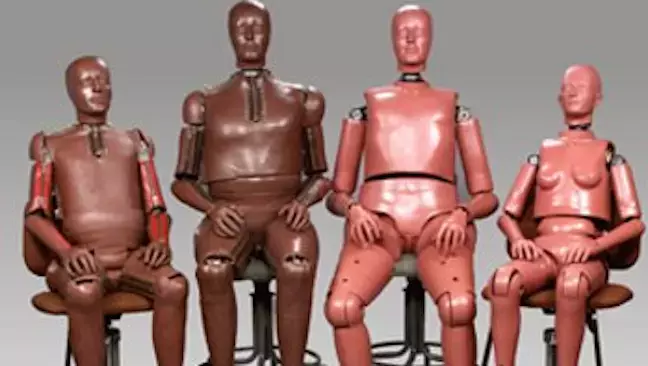Like any modern industry, the field of crash testing has been built on the shoulders of giants. And though early crash test dummies were a far cry from the high-tech ones we have today, they were instrumental in developing the standards of testing that make our cars increasingly safe.
Take a look at a few selections from the history of the crash test dummy to see how they went from humans to mannequins to human-like mannequins. Here are some of the big names:
Colonel John Paul Stapp — the crash test pioneer
The first crash test dummies may have been the best, most responsive, most lifelike dummies in history — because they were actual people. Colonel Stapp, an Air Force flight surgeon in the 1950s, noticed that more fighter pilots were dying in car crashes than in plane crashes.
So what did he do? He began a crash test study program, of course. To test the efficacy of seat belts, he put dummies into salvage cars and crashed them into wood or concrete barriers (sound familiar?). Humans also volunteered for these tests, withstanding up to 28 Gs (28 times the pull of gravity) or 4,800 pounds of force.
From his findings with real humans and real dummies, Stapp recommended several innovative features in car safety: doors with safety locks (so they wouldn’t fly open in a crash), improved bumper design, and dashboards with energy-absorbing padding.
While his insight was crucial to developing safety tests and procedures for the automotive industry, having human volunteers proved unfeasible, so they switched to the inanimate crash test dummies still in use today.

Sierra Sam — the first crash test dummy
Believe it or not, before crash test dummies were invented, cadavers, chimpanzees, hogs, and other animals were often used in crash tests.
This usage was problematic — for obvious reasons. Thankfully, dummies (aka anthropomorphic test devices) were developed in the late 1940s, and Sierra Sam was the very first one of them.
Like Stapp’s volunteers, Sierra Sam was used by the Air Force, where he had the lucky job of testing ejection seats. Good ole Sam may not have been testing car crashes, but he was certainly a big step in the right direction.
Hybrid I — the best of both worlds
Built by GM in 1971 as a compromise between two dummy models that didn’t quite make the grade — one from Alderson Research Laboratories and the other from Sierra Engineering (of Sierra Sam fame) — Hybrid I was the first in a series of modern crash test dummies. It proved to be durable and more capable of producing standardized results, but it still lacked the sophistication of modern dummies and couldn’t completely replicate how real humans are affected in a crash.
Hybrid III — the old-school “smart” dummy
The most popular dummy model currently used by the National Highway Traffic Safety Administration (NHTSA) in frontal crashes is the Hybrid III, a direct descendant of Hybrid I. Originally built in the 1970s, the Hybrid III is 5’9” and 173 pounds (about the size of the average adult male).
But there’s nothing average about this dummy. His upper torso has six high-strength steel ribs that can simulate human chest deflection (think of it as bones breaking). His lower torso has a rubber lumbar spine that curves just like ours when we sit.
THOR — the state-of-the-art ATD
Though Hybrid III is pretty advanced, NHTSA is always looking to propel crash testing forward. For the past few years, the administration has been working on a sophisticated new model called THOR. This one can better replicate actual human movement and is packed with a whole bevy of sensors to gather detailed information about what happens to our bodies in a crash.